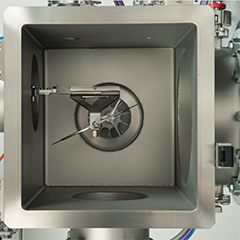In order to reach the final vacuum in a vacuum chamber, the material and the surface texture are very important. In addition, the gas load that is to be pumped down is relevant as to how quickly the desired final pressure can be obtained. The gas load, before reaching the desired base pressure, consists mainly of the leakage rate of the chamber and the gases and vapors adhering to the chamber walls and fixtures. They gradually desorb from the surface under vacuum.
This desorption has a great influence on the pump-down times and therefore on the length of time needed to reach the designated final pressure. The interaction of all parameters described above is reflected in the so-called pump-down curve, in which the pressure loss is shown as a function of time.
To increase the pump-down speed of a vacuum chamber, different measures are possible. The use of materials which gas and water vapor molecules adhere to less strongly reduces the pump-down time. An overview of the desorption rates for dry air from the surfaces of various materials is given in Table 1.
Due to the continuous removal of adhering gas particles during the pumping process, the gas delivery rates decrease with increasing pump-down time. In general, if the condition of the chamber is good and the pump design suitable, the ultra-high vacuum range can be achieved after a pump- down time of ten hours. From then on, the desorption of gases from the surfaces becomes less significant in comparison to the diffusion of gases from the materials and is there- fore no longer relevant for the pump-down time.
Compared with plastics, the outgassing rates of metals are much lower. Exceptions are, for example, copper alloys: they also have high outgassing rates. Plastics and metals with higher desorption rates are used in seals, as O-rings made of elastomers up to the high vacuum range or as metal seals in the ultra-high vacuum region.
The outgassing rate of elastomers can be reduced with different chemical compositions. Fluorocarbon compounds, for example, have a desorption rate an order of magnitude lower than nitrile rubber compounds.






























